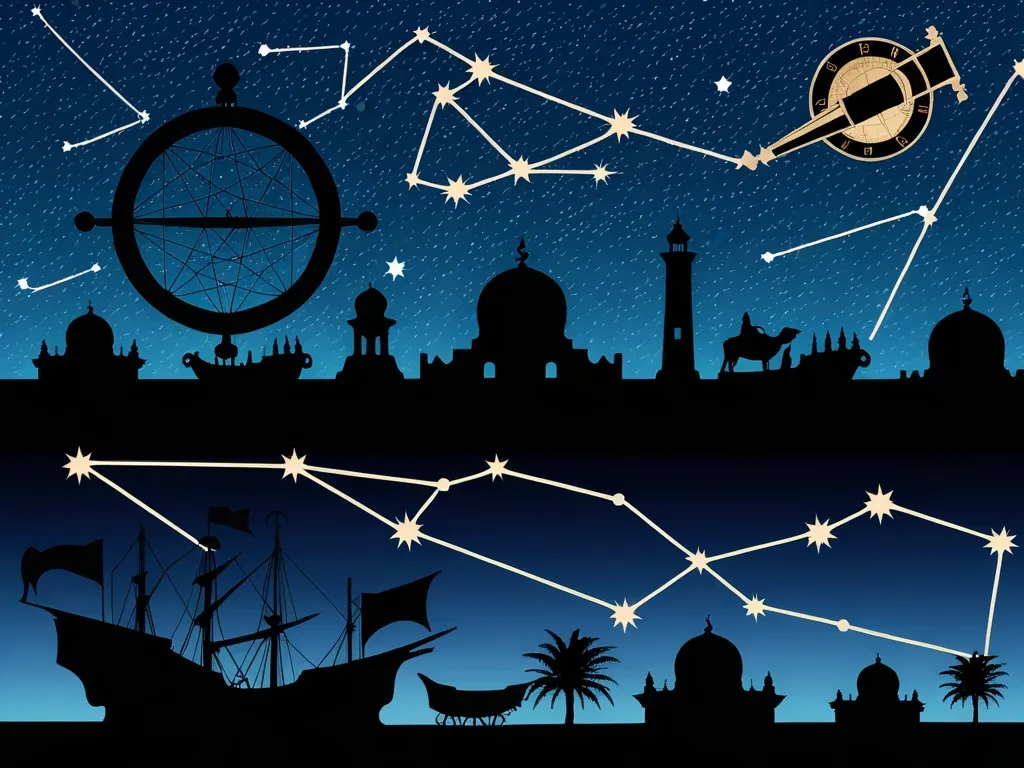As we navigate the complexities of today’s global economy, it’s easy to overlook the ancient roots that have shaped our modern world. One of the most fascinating aspects of this history is the interplay between astronomy and the emergence of ancient trade routes. The stars, once mere twinkles in the night sky, played a pivotal role in guiding journeys, facilitating trade, and fostering cultural exchange.
Imagine standing on the banks of the ancient Silk Road, a network of routes that stretched from China to the Mediterranean. Here, merchants and travelers relied heavily on celestial navigation to chart their courses. Astronomy was not just a science; it was an essential tool for survival and success. The positions of the stars and planets were meticulously observed and recorded, allowing travelers to predict weather patterns, seasonal changes, and even the best times for planting and harvesting crops.
Along these routes, astrology and astronomy were closely intertwined. Astrology, with its focus on the influence of celestial bodies on human affairs, was a respected academic discipline. It was used to make predictions about future events, understand human behavior, and even guide political decisions. This blend of science and superstition was a common thread in many ancient cultures, from the Babylonians to the Chinese during the Tang Dynasty. For instance, Chinese horoscopy, influenced by Hellenistic and Indo-Iranian systems, became an integral part of Chinese astrology, highlighting the cross-cultural exchange that occurred along these trade routes.
The Indian Ocean trade network, another significant ancient trade route, also relied heavily on celestial navigation. Here, the monsoons, with their predictable wind patterns, were a lifeline for sailors. Understanding when and where these winds blew was crucial for navigating the vast expanse of the Indian Ocean. The development of the astrolabe, an ancient astronomical instrument, was a game-changer. This handheld device could measure the altitude of celestial bodies, determine latitude, and even predict eclipses. It was a vital tool for sailors, helping them navigate safely and consistently across the ocean.
The astrolabe’s significance extended beyond navigation; it was also a symbol of the cultural and scientific exchanges that occurred along these trade routes. Invented by the ancient Greeks, it was widely used in the Islamic world during the Middle Ages and later in medieval Europe. In the Middle East, it helped Muslims find the direction of Mecca for prayer, while in Europe, it was used in astrology to make decisions based on visible constellations. This versatile instrument was a testament to the cross-cultural transmission of knowledge that characterized ancient trade networks.
Ancient observatories, such as the Goseck Circle in Central Europe, further illustrate the importance of celestial observations. Built around 7000 years ago, this Neolithic structure is one of the oldest known solar observatories in the world. It was designed to track the movements of the Sun and Moon, aligning with significant celestial events like the summer solstice. Such structures were not just scientific tools but also religious and cultural centers, where the cycles of nature were closely tied to the cycles of human life.
The impact of these celestial observations on trade and cultural exchange was profound. The ability to predict seasonal changes and celestial events allowed for more efficient agricultural practices and better planning for trade expeditions. For example, the alignment of the stars with the summer solstice could signal the beginning of the rainy season, a crucial piece of information for farmers and traders alike.
Moreover, the exchange of ideas and technologies along these trade routes was facilitated by the shared interest in astronomy. Indian astrology, for instance, was introduced into Central Asia and China through the Silk Road, often alongside the spread of Buddhism. Early Islamic astrologers incorporated Indian theories into their works, demonstrating the rich tapestry of cultural and scientific exchange that characterized these ancient networks.
The stories of famous travelers like Marco Polo, Ibn Battuta, and Ming Admiral Zheng He highlight the personal and cultural dimensions of these trade routes. These adventurers not only traded goods but also shared stories, ideas, and technologies that bridged vast distances and cultures. Their journeys, guided by the stars, left indelible marks on the world, shaping communities and fostering contact between diverse civilizations.
In conclusion, the connection between astronomy and ancient trade routes is a compelling narrative that underscores the ingenuity and curiosity of our ancestors. The stars, once mere points of light, became navigational aids, cultural symbols, and facilitators of global exchange. As we look up at the night sky today, we are reminded of the enduring legacy of those who came before us, who used the celestial bodies to chart their paths and build the foundations of our modern world.
This legacy is not just about the tools and technologies developed; it’s about the people who used them, the cultures they influenced, and the economic landscapes they shaped. The next time you gaze at the stars, remember that they are more than just a beautiful sight; they are a testament to the ancient commerce that has connected us all, across time and space.






